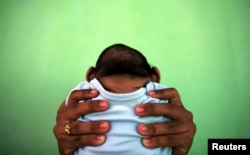As the Zika viral epidemic continues across the Americas, it’s projected that 93.4 million people in total could become infected before the epidemic burns itself out.
According to a new model developed by U.S., English and Swedish researchers, 1.6 million women of childbearing age could contract Zika from infected mosquitoes.
Experts say women who are infected with Zika during the early months of their pregnancy are at highest risk of giving birth to babies with microcephaly.
Babies born with microcephaly have small heads and brains, causing mental and physical disability, seizures and sometimes death.
Experts say not every pregnant woman infected with Zika will give birth to a child with severe birth defects.
But Alex Perkins, one of the model’s developers from the University of Notre Dame in Indiana, says the number of newborns born with the birth defect could nonetheless be significant.
“If you want to think about the numbers in terms of microcephaly and things like that, I think somewhere on the order of tens of thousands is what our numbers would suggest,” he said.
Since the end of June, there have been almost 1,650 confirmed cases of microcephaly in five countries.
The Zika projection model, published in the journal Nature Microbiology, is the most comprehensive estimate to date for Zika spread.
In developing their forecast, Perkins and colleagues used data from past epidemics of Dengue and Chikungunya. Dengue is in the same flavivirus family as Zika. Chikungunya, while in a different viral family, is also spread by mosquitoes and is endemic in the Americas.
All three can cause similar symptoms of headache, muscle ache and fever. But 80 percent of people who contract Zika have no symptoms at all.
Researchers also analyzed data on blood samples collected from people who have been infected with Zika so far. That gave them information to forecast the rate of transmission at the local level.
Unique model
The model is unique in that it also took into account a phenomenon called herd immunity, a tipping point in an epidemic when so many people contract an illness, others are protected against the disease.
“So really there’s going to be a large proportion of the population that remains uninfected after the epidemic," Perkins said. "And the epidemic is going to extinguish itself before it’s able to infect everyone.”
Other than herd immunity, there is currently no vaccine to shield people and pregnant women against Zika, which the World Health Organization declared a public health emergency earlier this year.










